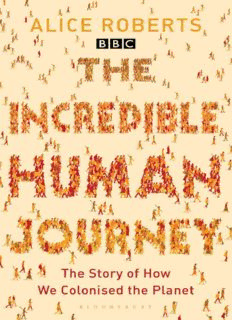Table Of ContentTo Jonathan Musgrave and Kate Robson-Brown,
wise friends and mentors
Contents
Introduction
1 African Origins
Meeting Modern-Day Hunter-Gatherers: Nhoma, Namibia
African Genes: Cape Town, South Africa
The Earliest Remains of Our Species: Omo, Ethiopia
Modern Human Behaviour: Pinnacle Point, South Africa
The First Exodus: Skhul, Israel
An Arabian Mystery: Oman
2 Footprints of the Ancestors: From India to Australia
Archaeology in the Ashes: Jwalapuram, India
Hunter-Gatherers and Genes in the Rainforest: Lenggong, Perak, Malaysia
Headhunting an Ancient Skull: Niah Cave, Borneo
The Hobbit: Flores, Indonesia
A Stone Age Voyage: Lombok to Sumbawa, Indonesia
Footprints and Fossils: Willandra Lakes, Australia
Art in the Landscape: Gunbalanya (Oenpelli), Northern Territory, Australia
3 Reindeer to Rice: The Peopling of North and East Asia
Trekking Inland: Routes into Central Asia
On the Trail of Ice Age Siberians: St Petersburg, Russia
Meeting with the Reindeer Herders of the North: Olenek, Siberia
The Riddle of Peking Man: Beijing, China
An Archaeological Puzzle: Zhujiatun, China
East Asian Genes to the Rescue: Shanghai, China
Pottery and Rice: Guilin and Long Ji, China
4 The Wild West: The Colonisation of Europe
On the Way to Europe: Modern Humans in the Levant and Turkey
Crossing the Water into Europe: the Bosphorus, Turkey
Face to Face with the First Modern European: Oase Cave, Romania
Neanderthal Skulls and Genes: Leipzig, Germany
Treasures of the Swabian Aurignacian: Vogelherd, Germany
Tracking Down the Last Neanderthals: Gibraltar
A Cultural Revolution: Dolni Vistonice, Czech Republic
Sheltering from the Cold: Abri Castanet, France
Visiting the Painted Caves: Lascaux, Pech Merle and Cougnac, France
New Age Mesopotamia: Göbekli Tepe, Turkey
5 The New World: Finding the First Americans
Bridging the Continents: Beringia
Mapping Native American Genes: Calgary, Canada
Exploring the Coastal Corridor: Vancouver, Canada
Finding Arlington Woman: Santa Rosa Island, California
Hunting American Megafauna: La Brea Tar Pits, Los Angeles
Clovis Culture: Gault, Texas
Meeting Luzia: Rio, Brazil
Ancient Hunter-Gatherers in the Amazon Forest: Pedra Pintada, Brazil
Black Soil and Revelations: Monte Verde, Chile
Journey’s End
References
Acknowledgements
A NOTE ON THE AUTHOR
Try to imagine the world in which humans have lived for the
overwhelming majority of our existence, a world without cities, settled
villages, or even permanent residences, a world without farmed fields
and crops, without possessions larger than those which we could easily
carry with us, and with everything we needed in daily life – all of our
tools, weapons and clothing – produced by ourselves or by those within
our small social bands. We did not grow food or have others grow it for
us, but instead exclusively relied upon our own knowledge of the
surrounding natural environment to survive, foraging for plant foods
1
and scavenging, hunting or fishing for meat.
D. J. Cohen
Introduction
We are very familiar with the idea that humans are everywhere; that wherever
you go in the world you will probably find people there already. We are an
unusual species in that we have a near-global distribution. And although people
around the world may look quite different from each other, and speak different
languages, they can nevertheless recognise each other as distant cousins.
But where and when did our species first appear? What are the essential
characteristics of our species? And how did people end up being everywhere?
These are rephrasings of fundamental questions. Who are we? What does it
mean to be human? Where do we come from? For thousands of years, such
questions have been explored through philosophy and religion, but the answers
now seem to lie firmly within the grasp of an empirical approach to the world
and our place within it. By peering deep into our past and dragging clues out into
the light, science can now provide us with some of the answers to the questions
that people have always asked.
They are questions that have always captivated me. As a medical doctor and
anatomist (I lecture in anatomy on the medical course at Bristol University), I
am fascinated by the structure and function of the human body, and the
similarities and differences between us and other animals. We are certainly apes;
our anatomy is incredibly similar to that of our nearest relations, chimpanzees. I
could put a chimpanzee arm bone, or humerus, in an exam for medical students
and they wouldn’t even notice that it wasn’t human.
But there are obviously things that mark us out – not as special creations, but
as a species of African ape that has, quite serendipitously, evolved in ways that
enabled our ancestors to survive, thrive and expand across the whole world.
There are aspects of anatomy that are entirely unique to us; unlike our arms, our
spines, pelvis and legs are very different from those of our chimp cousins, and no
one would mistake a human skull for that of another African ape. It’s a very
distinctive shape, not least because we have such enormous brains for the size of
our bodies. And we use our big brains in ways that no other species appears to.
Unlike our closest ape cousins, we make tools and manipulate our
environments to an extent that no other animal does. Although our species
evolved in tropical Africa, this ability to control the interface between us and our
surroundings means that we are not limited to a particular environment. We can
reach and survive in places that should seem quite alien to an African ape. We
Description:Alice Roberts has been travelling the world - from Ethiopian desert to Malay peninsula and from Russian steppes to Amazon basin - in order to understand the challenges that early humans faced as they tried to settle continents. On her travels she has witnessed some of the daunting and brutal challen

